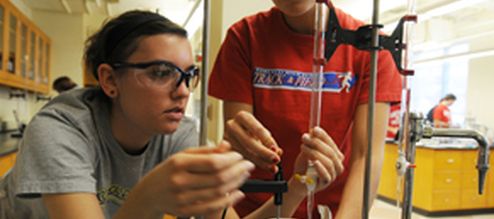Document Type
Article
Publication Date
5-8-1989
Publication Source
Proceedings of SPIE
Abstract
Experimental and theoretical evidence is presented which suggests that two distinct forms of light-adapted bacteriorhodopsin may exist. We propose that these two forms have characteristic photocycles with significantly different primary quantum yields. INDO-PSDCI molecular orbital procedures and semiempirical molecular dynamics simulations predict that one ground state geometry of bR undergoes photochemistry with a primary quantum yield, Φ1, of ~ 0.27, and that a second ground state geometry, with a slightly displaced counterion, yields Φ1 ~ 0.74. This theoretical model is supported by the observation that literature measurements of Φ1 tend to fall into one of two categories- those that observe Φ1 ~ 0.33 or below, and those that observe Φ1 ~ 0.6 or above. The observation that all photostationary state measurements of the primary quantum yield give values near 0.3, and all direct measurements of the quantum yield result in values near 0.6, suggests that photochemical back reactions may select the bacteriorhodopsin conformation with the lower quantum yield. The two photocycles may have developed as a natural biological requirement that the bacterium have the capacity to adjust the efficiency of the photocycle in relation to the intensity of light and/or membrane electrochemical gradient.
Inclusive pages
103-112
ISBN/ISSN
0277-786X
Document Version
Published Version
Copyright
Copyright © 1989, Society of Photo-Optical Instrumentation Engineers (SPIE)
Publisher
Society of Photo-Optical Instrumentation Engineers (SPIE)
Volume
1057
Peer Reviewed
yes
Sponsoring Agency
This work was supported in part by grants from the National Institutes of Health (GM-34548), the National Science Foundation (CHE-8S1615 S), and the Office of Naval Research (N00014-88-K-03S9).
eCommons Citation
Birge, Robert R.; Findsen, Leonore A.; Lawrence, Albert F.; Masthay, Mark; and Zhang, Chian-Fan, "Origins of the Quantum Efficiency Duality In the Primary Photochemical Event of Bacteriorhodopsin" (1989). Chemistry Faculty Publications. 80.
https://ecommons.udayton.edu/chm_fac_pub/80




Comments
One print or electronic copy may be made for personal use only. Systematic reproduction and distribution, duplication of any material in this publication for a fee or for commercial purposes, and modification of the contents of the publication are prohibited.
Permission documentation on file.